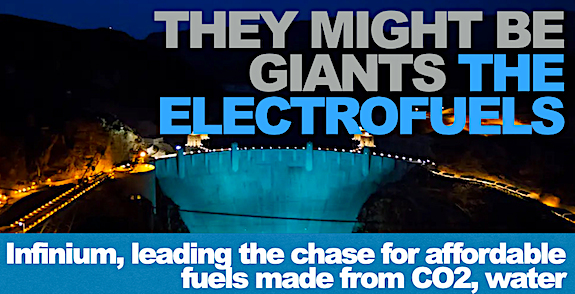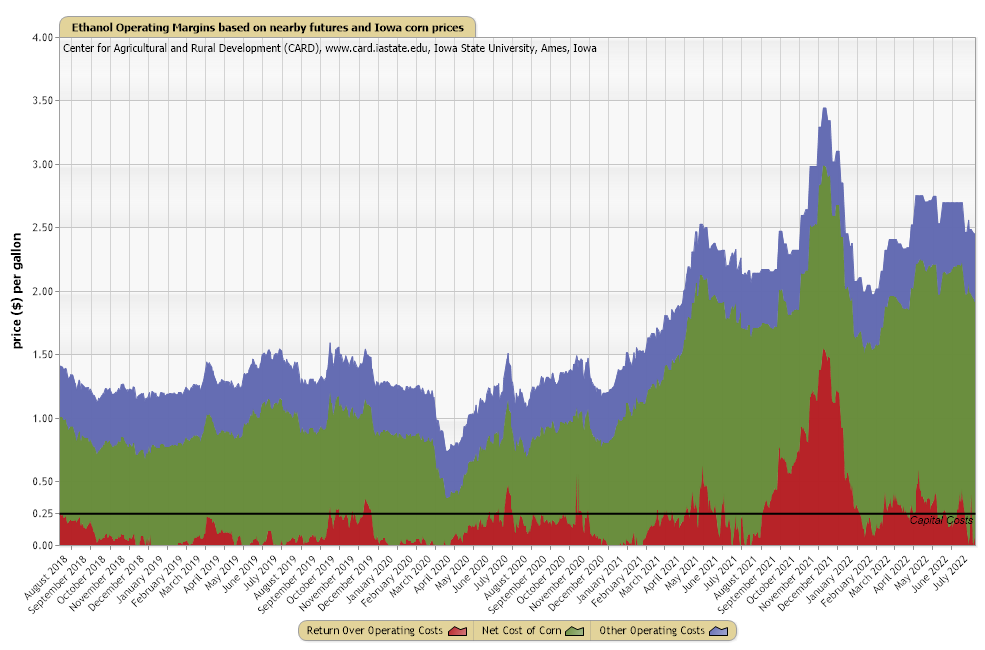Infinium and electrofuels: They Might Be Giants

The late, great Ron Cascone of NEXANT and the Due Diligence Wolfpack observed in The Daily Digest in 2018, “Major players in the fuels and chemicals industries have begun serious development of [new] processes that produce intermediates and finished products from carbon dioxide. One of the most interesting areas is in the many developments that use renewable electricity to convert CO2 to chemicals or fuels.”
Welcome to the electrofuels, which have been pursued in far-out development circles for more than a decade. In recent months, the activity has intensified. The reasons are three.
1. Maturing technology, and investable players emerging such as Infinium and Twelve.
2. The prospect of abundant renewable power by the late 2020s, leaving electrons available to split water to make hydrogen.
3. CO2 and water are the only feedstocks that have can match the cost and scale of petroleum, and the ultimate platform for liquid fuels at the kind of volumes that support all the Net Zero commitments.
Feedstock, technology and energy — add in the high price of carbon credits, and you have the ingredients for explosive growth. Perhaps now. Perhaps massive.
The electrofuels competitive edge – cheap, abundant feedstock
Here’s the key thing. Water costs around a penny per gallon at wholesale rates, and CO2 has a permanent cost cap, more or less, and it’s free forever, if you own a means of production.
Did I hear you right, guv’nor? Free forever?
Yep, this chart from the Center for Agricultural and Economic Development at Iowa State shows why. It charts ethanol profitability over several years — that’s the red.

Bottom line, there’s 11 pounds of CO2 for every fermented bushel of corn, and its paid for by the sale of ethanol, corn oil and animal feed. Hence, if you own the means of production, you can make CO2 for free. I might add, high-grade, low impurity CO2.
In a gallon of fuel made from CO2 and water, the yields are low because all the oxygen is jettisoned, and its going to take 20 gallons or so of water to make a gallon of fuel, which is to say that there’s around a 30 cents of inputs. That’s roughly the cost of the inputs when you have $12 oil and you’re making fuels the old fashioned way at the refinery. Refinery size should be expected to be smaller, and with capex and so forth, carbon credits are going to be welcome, and necessary at times of super low cost oil, such as the $15 figure seen in 2015.
But here’s a technology that carbon credits were made for. At worst the carbon score will be in the single digits or low teens, and it could go negative depending on the source of the CO2.
Why bother?
When you have wind and solar, why bother? Aren’t all low carbon fuels destined to fail?
Well, think of it this way,
1. Water and CO2 are perhaps the only feedstocks in the world that make petroleum look like a small-time enterprise.
2. You can distribute electrofuels into every jet and truck in the world, no engine modifications, no car factory retooling, no permitting, no kidding. This scales fast.
The Infinium backstory
We’ve been highlighting Infinium for some time and more so in recent months. There’s investment flow — always a positive sign on the assumption that the investors did the due diligence before signing checks. There’s project deal flow. We reported on this one and this one.
How does Infinium do it? Well, think of three technologies. First, splitting hydrogen using commercial electrolyzers. Second, carbon dioxide and hydrogen — that’s the reverse water gas shift, you get water and carbon monoxide with that. Now, take that CO, add more hydrogen, now you have syngas, and now you can do some catalytic hydrogenation, also known as the Fischer-Tropsch synthesis.
The Fortunatelys and Unfortunaltelys
Unfortunately, one of the challenges with F-T is that you get a lot of wax — converting that to fuel is not for the faint of heart.
Fortunately (and now we enter into the world of secret sauces and claims, which is to say the world of Mysterious Catalysts), Infinium says they have a proprietary catalyst that makes little wax, and a lot of liquid hydrocarbons.
Unfortunately, there’s not much independently-verified evidentiary proof that verifies the tasty claim. Just yet.
Fortunately, Infinium’s in good company. No one reveals anything, ever, about the catalyst, It might be easier to get the nuclear launch codes than get a company to reveal its catalyst secrets. So the fact that Infinium is not revealing much, that’s par for the course.
Unfortunately, we have a new company and catalyst here, so if you’d like to be a Missourian and shout “Show-Me!”, you won’t be alone. Skeptics will abound for a while and Infinium will prove out at scale or it won’t. Signs have been good so far.
So, fortunately, we have a candidate for the They Might be Giants department in the bioeconomy. Claims are not proof, plans are not refineries, spreadsheets are not costs, projections are not profits. So, as the Zen master said, we’ll see.
Cautionary note
The capex for this system is going to be high. F and T may be the most expensive letters in the Bioeconomy Wheel of Fortune. And we’ll need to watch for progress in the cost of commercial electrolyzers, which Infinium does not make, Costs need to come down. Manufacturers tout that capex may come down as much as 75 percent. That’ll help ease the project pain. Will those costs really come down, and when? That’s a $64,000 Question for friends of Infinium.
The Bottom Line
Early days. Watch these projects. Watch electrolyzer costs. Watch the start-up of the this project or that. Those three will tell us much.
Category: Fuels















